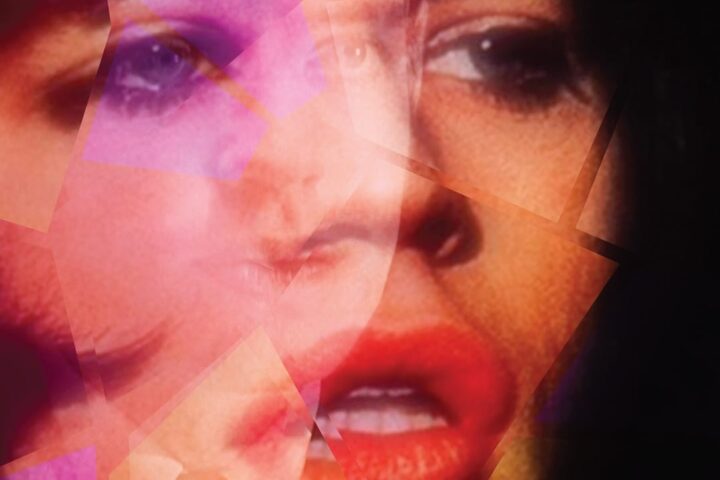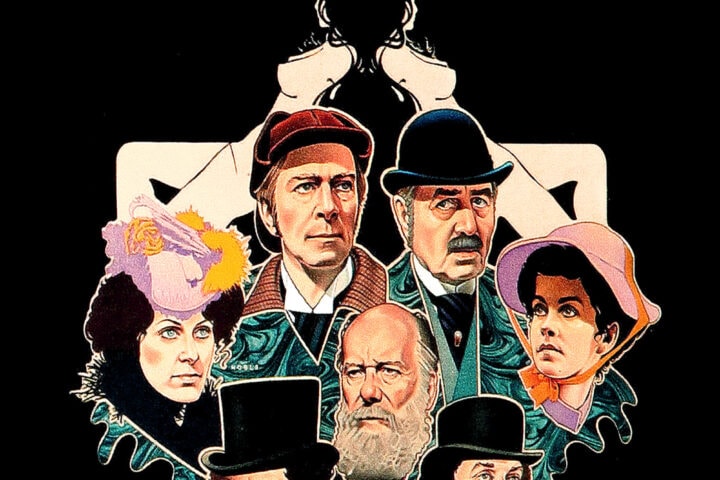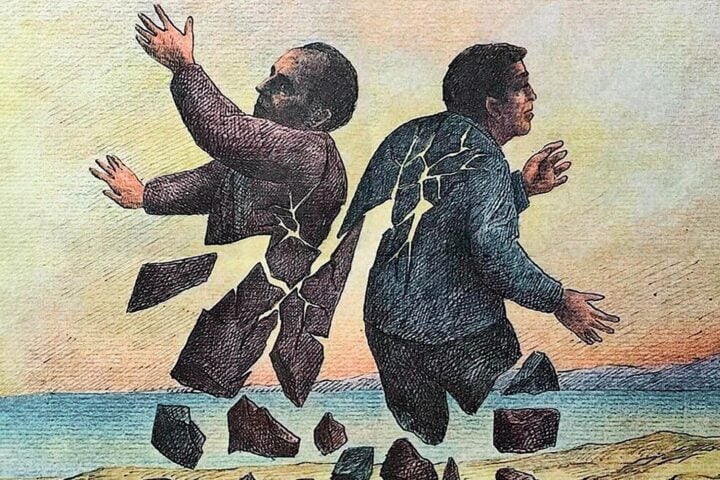Nineteen sixty-eight has to be considered the apex of psychedelic sexploitation romps, with the release of Candy, adapted from Mason Hoffenberg and Terry Southern’s satirical reworking of Voltaire’s Candide, and Roger Vadim’s Barbarella, based on Jean-Claude Forest’s comic, and partially scripted by Southern (alongside an armada of other credited writers). Both employ a rambling, shaggy-dog structure as an excuse to flagrantly foreground softcore sexual hijinks tinged with a pungent whiff of social commentary, albeit the latter aspect may be easier to discern in Candy’s perverse daisy chain of events.
Southern’s contributions to the Dino De Laurentiis-produced Barbarella can be detected in some of its wittier lines (“A good many dramatic situations begin with screaming!”) and sly pokes at the persistence of class-consciousness (in the far-flung future, only the poor still “make love” in a physical sense). Aside from Southern, the two films are linked by the presence of Anita Pallenberg, style icon and muse of the Rolling Stones: She was the romantic partner of Brian Jones and, later, Keith Richards, while starring with Mick Jagger in Nic Roeg and Donald Cammell’s Performance. Pallenberg provided little more than a walk-on for Candy but secured a significant role in Barbarella as the Great Tyrant of Sogo, even if her Teuton-toned delivery was dubbed by throaty British actress Joan Greenwood, doyenne of several Ealing comedies.
Barbarella delivers equal doses calculated camp comedy and unintentional hilarity: wink-wink double-entendres, ropey low-fi effects, and saccharine songs. The film opens with star Jane Fonda performing a zero-G spacesuit striptease, set to a swinging title song unafraid to rhyme “Barbarella” and the non-word “psychedela,” as the credits coyly cloak her prurient parts. More remarkable still, the set design features a cockpit lined with hideous brown shag carpet, a half-nude statue that doubles as a two-way viewing screen, and a clackety A.I. abacus that speaks with a lisp (providing the butt for the first of several ill-advised gay jokes).
Caught in flagrante by the president of Earth (Claude Dauphin), our not-so-obscure object of desire gets debriefed on her new mission: The “5-star, double-rated astro-navigatrix” has been assigned to track down scientist Durand Durand and gain possession of his fantastic laser-powered weapon, the positronic ray. If all this smacks of some sub-Flash Gordon storyline, it’s hardly a coincidence, since Barbarella takes many cues—and lifts its deliberately retro sparkler-rocket effects—from the old Buster Crabbe serials. A similar aesthetic would inform Mike Hodges’s Flash Gordon remake, though that film (also produced by De Laurentiis) simultaneously dials up the camp and tamps down on the erotica.
But Barbarella consistently puts the erotic front and center. On icy Tau Ceti, our heroine runs into hirsute Mark Hand (Ugo Tognazzi), who rounds up the local children when they reach a “serviceable” age, perhaps indicating an economy based on sexual servitude. For Hand, at any rate, sex with Barbarella serves as a form of payment, in lieu of “governmental recompense.” The film treads lightly when it comes to the suggestiveness of these matters, but, given Southern’s penchant for satirical kink, the full implication is there for those given to ponder.
When Barbarella encounters rebel leader Dildano (David Hemmings)—the name itself slyly conjures up the image of a sex toy—they indulge in a rarefied form of hand-to-hand mind-fuckery. This is apt for a film that never seems to take the counterculture’s partiality for radical chic too seriously. Far better to kick back, hookah in hand, and partake of some freshly extracted “essence of man.” This notion is only further confirmed at the end of the film when Durand Durand (Milo O’Shea) blasts Dildano and his revolutionary comrade Professor Ping (Marcel Marceau) into atoms and the action barely pauses to acknowledge their passing.
The real focus of the narrative at this juncture is on Durand Durand and his Excessive Machine, an invention that Woody Allen would parody as the Orgasmatron in 1973’s comedy classic Sleeper. Durand’s device—it most closely resembles an organ, with all that implies—is an extension of his manhood, meant to overwhelm and destroy Barbarella with its supernumerary virility, only for her to take it all in stride. She more than matches the man but never loses her aura of naïveté. On the other hand, Durand comes totally unmanned, looking like an unholy hybrid between a demented Beethoven and a lurid purple Big Bird.
Barbarella closes with an image that hovers between licentiousness and innocence: The angel Pygar (John Phillip Law), whose inability to fly was cured via a liaison with Barbarella, carries her and the Black Queen (Pallenberg) away from the burning wreckage of Sogo, the City of Night. On the one hand, it could be read as implying an incipient ménage à trois. On the other, the persistent emphasis on “love” throughout the film, from its use as a signoff to the claim that “an angel is love,” seems to indicate that the ethos of the Summer of Love, taking place in San Francisco at the same time that the film was being shot in De Laurentiis’s Dinocittà film studios in Rome, somehow permeated Vadim’s production. Ultimately, Barbarella remains a stylish time capsule of that tumultuous era, as well as a trippily designed bit of retrofuturism.
Image/Sound
The 2160p transfer of Barbarella on this Arrow Video release looks simply stunning, and that’s pretty important for a film whose greatest assets include its sumptuous cinematography (courtesy of Claude Renoir) and psychotronic set and costume design. Colors are a searing riot of vibrant hues, including those whirling liquid light shows cascading in the background of many scenes. The image possesses some impressive depth, and the clarity of fine details is finely etched. Audio comes in several options: English and French mono (incidentally, Jane Fonda dubs herself in the latter) for the purists, and a rejiggered Dolby Atmos track that’ll rattle the pictures on your walls. There’s also the option to listen to an isolated score track that provides the full Bob Crewe experience as performed by Glitterhouse.
Extras
This is another gorgeously packaged release from Arrow Video with striking art from Tula Lotay featured on the reversible sleeve and double-sided poster alongside the original artwork. Six art cards are tucked into the Blu-ray case, and the copiously illustrated book contains four new essays on various aspects of the film, and also a reproduction of the original pressbook. The UHD disc contains a deeply researched and eminently listenable from novelist and critic Tim Lucas, who covers the source material, the production history and its links to Danger: Diabolik (which was filmed on some of the same sets right after Barbarella), the career arc of cowriter-director Roger Vadim, and the film’s sociopolitical subtexts.
The rest of the extras can be found on a second disc. Lucas is joined by comics artist and film historian Stephen R. Bissette for a nearly two-hour Zoom confab that covers a wide array of topics in fascinating detail: the history of Jean-Claude Forest’s comics in France and the U.S., Barbarella’s links to avant-garde art and literature, the film’s place among the other key sci-fi releases of 1968 (Franklin J. Schaffner’s Planet of the Apes and 2001: A Space Odyssey), and the legacy of the “Barbarella archetype” found in works like Valérian (both comics and film version) and Luigi Cozzi’s amazing Star Crash.
Elsewhere there’s an appreciation of the film by critic Glenn Kenny, who touches on the careers of producer Dino De Laurentiis and actress Jane Fonda, and an amusing archival featurette with lots of behind-the-scenes action. Then there are a handful of new on-camera interviews: Fashion scholar Elizabeth Castaldo Lundén discusses Jacques Fonteray’s costume designs; camera operator Roberto Girometti talks about working with DP Claude Renoir; actor-director Ricky Tognazzi outlines his father’s career and politics; actor Fabio Testi recalls working as John Phillip Law’s stunt double. Rounding things out is a compact visual essay on the life and career of producer De Laurentiis by critic Eugenio Ercolani.
Overall
Available in stunning 4K UHD, Roger Vadim’s outrageous ode to all things “psychedela” gets Arrow Video’s typically sumptuous packaging.
Since 2001, we've brought you uncompromising, candid takes on the world of film, music, television, video games, theater, and more. Independently owned and operated publications like Slant have been hit hard in recent years, but we’re committed to keeping our content free and accessible—meaning no paywalls or fees.
If you like what we do, please consider subscribing to our Patreon or making a donation.




Great review! Looking forward to getting my copy. By the way, what was the gay joke with the A.I. you alluded to? Is it the line where she says “You wouldn’t understand?” after hooking up with Mark Hand?
I still haven’t yet and probably won’t become rich enough to ever upgrade to 4K (some of us still barely make it month to month and the players alone are still almost $300) but I still appreciate the standard Arrow makes with their efforts. To keep the home video market alive. I feel like the national anger over so many having their wallets tightening has to have an effect on the boutique labels soon enough…
How can collectors magically live in a niche all our own for so long? I have to keep buying from Amazon Prime (despite their overlord evils) because they have the best prices (and… again: month to month) but recently their “Prime Shipping” has been getting sparse as it was in spring, 2020. When you could order but 2-Day Arrivals have not been the standard the past couple weeks… Things are starting to take a week or more to arrive and that cannot just be “Black Friday.” Nor is it just Amazon trying to get buyers angry at unions and strikes.